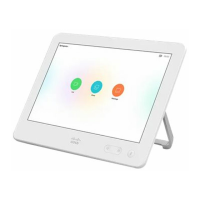
Do you have a question about the Cisco Touch10 and is the answer not in the manual?
| Display Size | 10.1 inches |
|---|---|
| Resolution | 1280 x 800 pixels |
| Touch Technology | Capacitive |
| Connectivity | Ethernet, Wi-Fi |
| Power | Power over Ethernet (PoE) |
| Mounting | Tabletop or wall mount |
| Processor | ARM-based processor |
| Compatibility | Cisco video conferencing systems |
Defines key terms used in the document related to video systems and control.
Explains how to customize the Touch 10/DX user interface for peripheral control.
Guides on creating custom user interface panels for peripheral controls on the Touch10/DX.
Steps to access and start the In-Room Control Editor via the web interface.
Provides an overview of the In-Room Control Editor interface and its functionalities.
Details how to connect to the video system and communicate using the API.
Covers events for widget actions, distinguishing between terminal and XML output modes.
Explains events for panel updates and page opening/closing.
Discusses commands and statuses for widgets, including SetValue.
Introduces widgets as user interface elements and explains widget identifiers.
Describes the two-state switch widget, its events, and commands.
Details the slider widget for value selection, its events, and commands.
Covers the button widget, its states, events, and commands.
Explains the group button widget for linked selections, events, and commands.
Describes icon buttons, their behavior, events, and commands, similar to text buttons.
Details the spinner widget for stepping through values, its events, and commands.
Explains the text widget for displaying information, its events, and commands.
Describes the directional pad widget, its buttons, events, and use cases.
Explains the spacer widget as a layout tool with no associated events or commands.
Details the various events sent by the video system for widget actions.
Continues the description of events, including Widget Action and LayoutUpdated.
Lists and explains commands like SetValue, UnsetValue, and Clear.
Explains how to retrieve widget status using the xStatus command.
Explains how to configure and use external video switches with the Cisco codec.
Provides details on commands for managing external video sources.
Illustrates a practical setup and configuration for using a video switch.
Guides on using web interface tools like Log and Widget State Overview for troubleshooting.
Offers best practices for event feedback, widget initialization, and panel updates.
Continues best practices with examples for lights, temperature, blinds, and buttons.
Explains administrator rights and user account creation for accessing the editor.
Provides instructions on how to launch and use the In-Room Control simulator.
